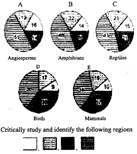
Given below are pie diagrams A, B, C, D, and E related to the percentage of various categories of threatened species of angiosperms, amphibians, reptiles, birds and mammals respectively.
Identify the each shaded
 slice of the pie chart.
A.
slice of the pie chart.
A.

B.

C.

D.






Answer
367.2k+ views
Hint:
Looking at the IUCN Red List can help one determine the current state of the world's biodiversity.t is a powerful instrument to inform and spark action for biodiversity conservation and policy change, crucial to preserving the natural resources we need to survive, and is much more than a list of species and their status.
Complete step by step answer:
On Earth, animals make up more than 70% of all known species, with plants (including algae, fungi, bryophytes, gymnosperms, and angiosperms) making up no more than 22% of the total.
Since the 1980s, frog populations have been declining globally, including through population decline and isolated mass extinctions. This revealed that at least 43% of species were experiencing some sort of population decline, and that 32% of species were globally threatened. As of 2010, 650 amphibian species were listed as "Critically Endangered" and 35 were listed as "Extinct" on the IUCN Red List, which incorporates the Global Amphibian Assessment and subsequent updates.
The International Union for Conservation of Nature's Red List estimates that 20% of examined reptiles worldwide are endangered.
A total of 1,180 bird species, or 13% of all species in the world, are thought to have populations below 5,000. The International Union for Conservation of Nature would classify a species as endangered if its total population was less than 2,500.
Only roughly 0.03 percent of the biomass on Earth is made up by mammals, including people and their pets. Only 0.37 percent of biomass is made up of all animals, including fish, insects, worms, birds, and other creatures besides mammals.
Hence option B is the correct answer.
Note:
The particular habitats where endangered species live are best protected, according to scientists. There must be locations for wildlife to live, feed, and rear their young. The deterioration of habitat is a result of logging, oil and gas drilling, overgrazing, and development.
Looking at the IUCN Red List can help one determine the current state of the world's biodiversity.t is a powerful instrument to inform and spark action for biodiversity conservation and policy change, crucial to preserving the natural resources we need to survive, and is much more than a list of species and their status.
Complete step by step answer:
On Earth, animals make up more than 70% of all known species, with plants (including algae, fungi, bryophytes, gymnosperms, and angiosperms) making up no more than 22% of the total.
Since the 1980s, frog populations have been declining globally, including through population decline and isolated mass extinctions. This revealed that at least 43% of species were experiencing some sort of population decline, and that 32% of species were globally threatened. As of 2010, 650 amphibian species were listed as "Critically Endangered" and 35 were listed as "Extinct" on the IUCN Red List, which incorporates the Global Amphibian Assessment and subsequent updates.
The International Union for Conservation of Nature's Red List estimates that 20% of examined reptiles worldwide are endangered.
A total of 1,180 bird species, or 13% of all species in the world, are thought to have populations below 5,000. The International Union for Conservation of Nature would classify a species as endangered if its total population was less than 2,500.
Only roughly 0.03 percent of the biomass on Earth is made up by mammals, including people and their pets. Only 0.37 percent of biomass is made up of all animals, including fish, insects, worms, birds, and other creatures besides mammals.
Hence option B is the correct answer.
Note:
The particular habitats where endangered species live are best protected, according to scientists. There must be locations for wildlife to live, feed, and rear their young. The deterioration of habitat is a result of logging, oil and gas drilling, overgrazing, and development.
Recently Updated Pages
What is glandular epithelium class 11 biology NEET_UG

The common characteristics between tomato and potato class 11 biology NEET_UG

Why are manures considered better than fertilizers class 11 biology CBSE

Find the coordinates of the midpoint of the line segment class 11 maths CBSE

Distinguish between static friction limiting friction class 11 physics CBSE

The Chairman of the constituent Assembly was A Jawaharlal class 11 social science CBSE

Trending doubts
What is BLO What is the full form of BLO class 8 social science CBSE

What is meant by exothermic and endothermic reactions class 11 chemistry CBSE

Which places in India experience sunrise first and class 9 social science CBSE

What are the major means of transport Explain each class 12 social science CBSE

Which are the Top 10 Largest Countries of the World?

Fill the blanks with the suitable prepositions 1 The class 9 english CBSE




